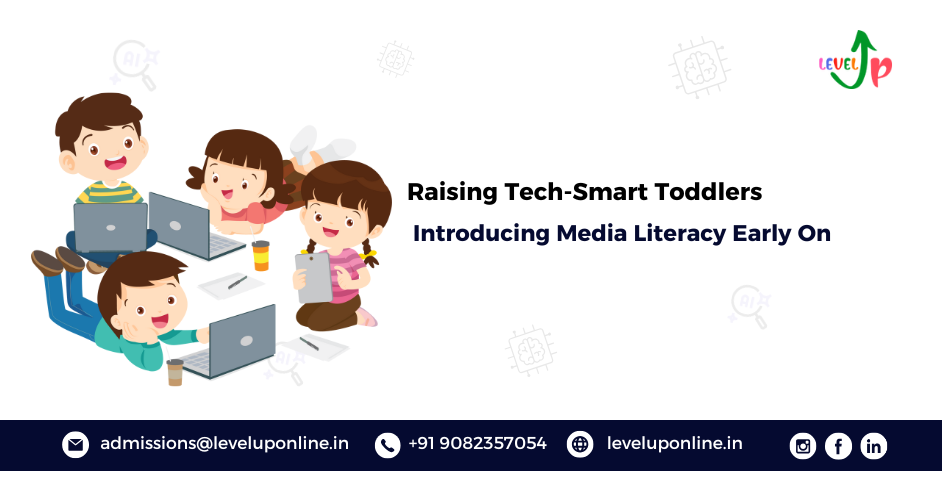Introduction: Toddlers in a Digital Age
We’re raising kids in a time where YouTube, tablets, and smartphones are part of daily life—often before they can even talk properly. That’s why media literacy in ECCE (Early Childhood Care and Education) is no longer optional—it’s essential. We need to teach children not just how to use technology but how to understand, question, and interact with it safely and responsibly. And yes, it starts as early as toddlerhood.
What Is Media Literacy in ECCE?
Media literacy in ECCE is the ability of young children to access, understand, evaluate, and create media in a variety of forms. It includes:
1. Knowing how to use digital tools safely.
2. Recognizing the purpose of media (informative, entertaining, persuasive).
3. Asking critical questions like “Is this real?” or “Who made this and why?”
In simple terms, it’s not just about watching Peppa Pig—it’s about helping kids make sense of what they see.
Why Early Introduction Matters
Early childhood is when foundational cognitive, social, and emotional skills develop. Introducing media literacy in ECCE at this stage helps children:
1. Build critical thinking from the start.
2. Develop healthy tech habits early.
3. Avoid becoming passive consumers of digital content.
By waiting too long, we risk letting technology shape their thinking before we can teach them how to think for themselves.
Screens Are Everywhere: What Can We Do?
From car rides to doctor’s offices to dining tables—screens are omnipresent. Instead of banning them outright (which often backfires), the smarter move is to guide how toddlers use these screens. That’s where media literacy in ECCE steps in—not to eliminate media, but to make toddlers smarter and safer while using it.
Benefits of Media Literacy in Early Years
Here’s what happens when we build media literacy in toddlers:
1. Improved Language Skills: Thoughtful use of digital storytelling apps and interactive e-books can enhance vocabulary.
2. Stronger Focus: Kids learn to actively engage with content instead of just zoning out.
3. Better Emotional Regulation: Recognizing emotions in videos or games helps toddlers learn empathy.
4. Cognitive Development: Simple media analysis fosters logical thinking and decision-making.
These benefits make it clear why media literacy in ECCE is a pillar of modern early education.
The Role of Parents in Digital Learning
Parents are the first teachers, especially when it comes to tech use. Here’s how they can nurture media literacy:
1. Model healthy tech use—if you’re always on the phone, toddlers will follow.
2. Co-watch and co-play—engage in digital experiences together.
3. Ask questions—“What’s happening in this video?” or “Why do you think that character is sad?”
The goal isn’t to police—it’s to participate and guide.
Creating Media-Literate Classrooms in ECCE
Early childhood classrooms should be equipped not just with technology but with intentional tech practices. Educators can:
1. Use apps and programs that align with learning goals.
2. Integrate media analysis in storytelling sessions.
3. Encourage students to express what they understood from a video or animation.
Remember, media literacy in ECCE isn’t about just using tech—it’s about thinking with tech.
Teaching Toddlers to Question, Not Just Consume
A major component of media literacy is asking why and how—even for toddlers. Yes, they’re small, but they’re smart!
You can start with:
1. “Do you think this story could happen in real life?”
2. “What do you think will happen next?”
3. “Who do you think made this game?”
These simple questions lay the groundwork for critical thinking.
Safe Digital Navigation: Teaching Smart Habits
Toddlers must learn basic safety concepts:
1. Don’t click on unknown pop-ups.
2. Ask before downloading or watching something.
3. Recognize when something makes them feel uncomfortable or scared.
Media literacy in ECCE includes emotional safety—not just digital rules.
Using Technology as a Learning Tool, Not a Distraction
There’s a fine line between using tech for learning and using it for babysitting. Intentionality is key.
Choose tech that:
1. Supports storytelling, problem-solving, and creativity.
2. Offers age-appropriate content with no ads.
3. Involves physical movement or interaction, not just passive watching.
Balancing Online and Offline Experiences
Media is a supplement—not a substitute—for real-life learning.
Encourage toddlers to:
1. Draw what they saw in a video.
2. Act out a favorite digital story.
3. Compare what they learned online with what they experience outdoors.
The balance between real and virtual play ensures healthy development.
Red Flags: Signs of Tech Overload in Toddlers
Too much or poorly supervised media can harm development. Watch out for:
1. Reduced attention span
2. Irritability when screens are taken away
3. Sleep disruption
4. Delay in speech or social interaction
If these signs appear, reassess how tech is being used at home or school.
Best Practices for Screen Time in ECCE Settings
Experts recommend the following:
1. 0–18 months: Avoid screen time except for video chats.
2. 18–24 months: Watch together; choose high-quality content.
3. 2–5 years: Limit to one hour/day of supervised, educational content.
Most importantly, media literacy in ECCE means helping kids engage with what they watch—not just counting minutes.
Empowering Toddlers with Digital Boundaries
Boundaries are a sign of love, not restriction.
Teach toddlers:
1. To ask before using devices.
2. That screen time has a start and end.
3. That boredom is okay—it often leads to creativity.
Boundaries help toddlers learn that they are in control, not the screen.
Conclusion: Building a Foundation for the Future
Media is here to stay, and toddlers are growing up with screens from day one. Instead of fearing it, let’s teach them how to use it wisely. With strong media literacy in ECCE, children can become curious, critical, and confident digital citizens. It’s not just about avoiding harm—it’s about unlocking new ways of thinking, learning, and expressing.


